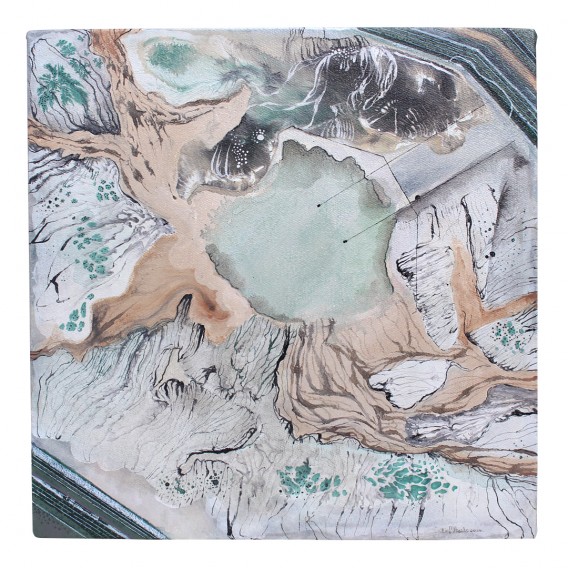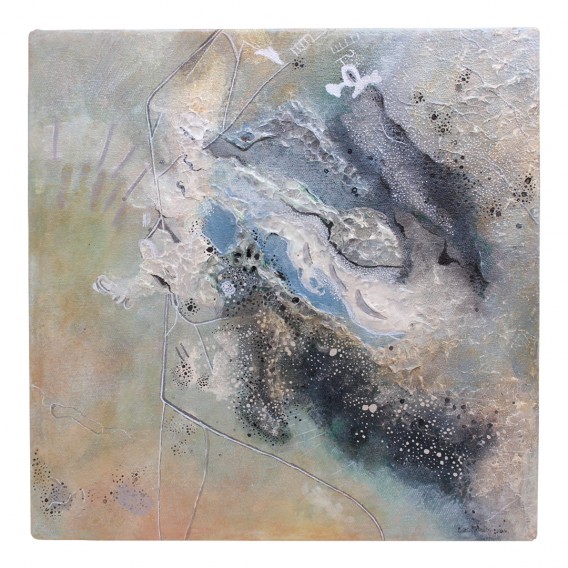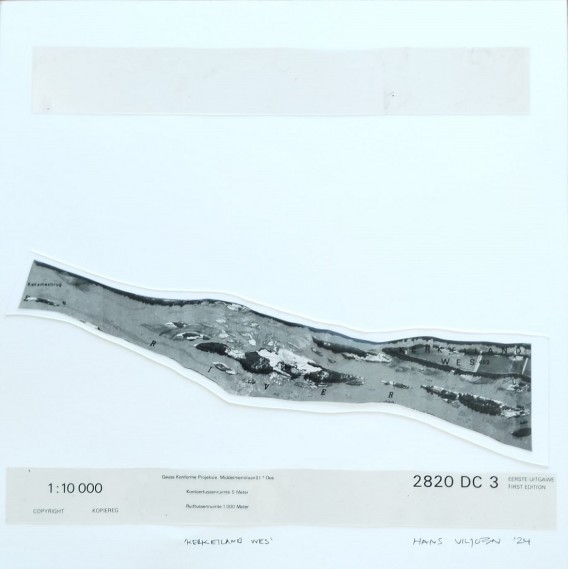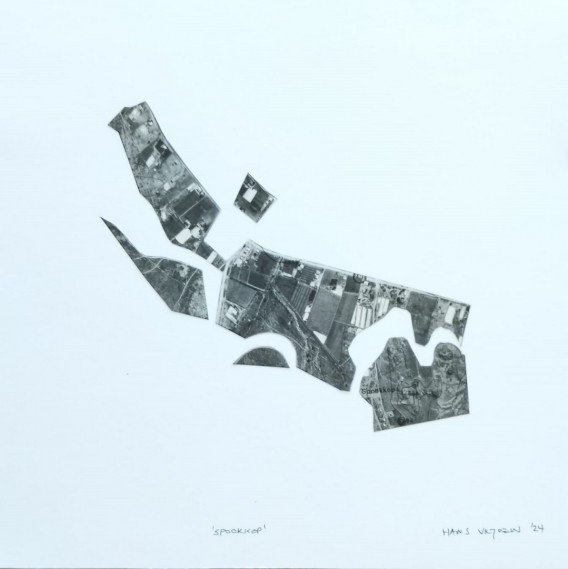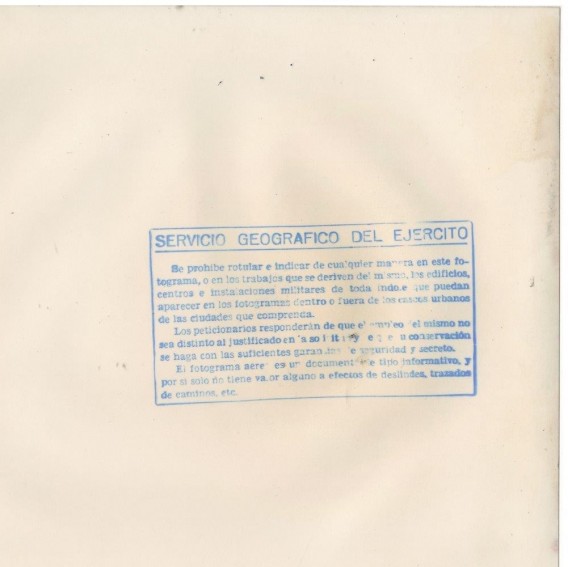Mineral extraction and land issues have defined Africa’s cultural and socio-political identity, and the impact of colonialism and globalisation affects how we occupy our current landscape in this Age of Acceleration.
Exhibition central concept is focussed on exploration and interrogation of environmental Stewardship embracing a trans-disciplinary approach. The artworks are arranged to alert the audience towards responsible custodianship of our only habitat, Earth. This will be done through a visual exhibition of aerial photographs, geomatics, artworks along with laws, and images of geo-surveillance less than 30 x 30cm.
The exhibition includes artworks that explore the role of imposed laws in colonial conquest of Africa. The consequences of gridding and dividing land with surveys and laws and the impact on colonial acquisition and Earth Stewardship in the Critical Zone.
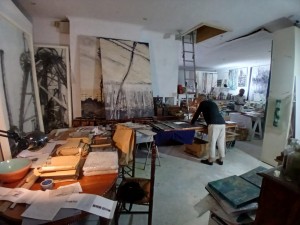
The Unite Project Space in Cape Town has hosted group artists exhibitions over the past two decades. This includes “Innovative Woman” curated by Bongi Bengu which inadvertently launched Zanele Muholi because of the controversy around the minister of Arts and Culture refusing to open the previous iteration at Constitution Hill. See here .
Various art workshops, SASOL and ABSA art competition briefs and other cultural events have been hosted in the space.
The ATLAS project is driven by Jeannette Unite whose transdisciplinary artistic research focus for nearly 30 years has been Earth/ environment/ geology and humans’ relationship with mineral extraction historically and the heritage mines from which they are extracted.
ATLAS is an invited group of artists, historians, Earth Scientists, and surveyors from African countries whose minerals are exploited by corporations and stock exchanges that are based on other continents.
The vision is to get a thousand voices on land occupation and use as well as the minerals of so-called 3rd world countries that are subject to neo-colonialism of their natural resources.
The artists, historians, geologists invited, and to whom the project is open, have shown a conceptual interest in land/ environment/ mining/ minerals and materiality and law, based on an installed matrix of two rescued aerial photographic archives:
- The Department of Earth Sciences at Oxford University Aerial photographs (size under 30 x 30cm) gifted to me because they are obsolete teaching aids and include stereoscopes for creating 3-D images of the Isle of Skye (Scotland, Great Britain) and Spain.
- The other geo-cadastrals are the duplicate negatives and aerial photographs from South Africa’s Land Planning department. I was also gifted these, which were going to be recycled for the silver.
The group project MINE|ATLAS had its first iteration at Turbine Art Fair in Johannesburg in June 2023
PARTICIPANTS
- Jeannette Unite
- Strijdom van der Merwe
- Diane Vives
- Jean Dreyer (curator (and artist) of ARTWORDS at Glen Carlou Gallery)
- Alta Botha
- Bongi Bengu (Bongi is an artist and curator)
- Theophilus Rikhotso
- Pwavidon Mathias (Nigeria / AEON Nelson Mandela University)
- Jeff Allan ( sculptor print Nelson Mandela University)
- Thembinkosi Goniwe
- Bongi Dhlomo
- Patrick Mautloa
- Turiya Magadlela
- Jade Davenport MINING Historian
- Aeon Earth Scientist Dr Linol
- Kathy Robins
- Memory Biya NAMIBIA Histprian
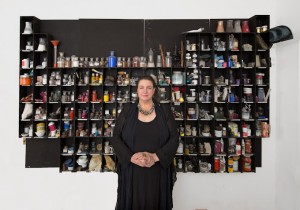
Jeannette Unite in front “The Artists Paintbox” – a Periodic Table incorporating samples of slimes dam, smelter slags and mine dump extracted material as well as objects that are made from these elements.
Jeannette Unite has focused on Africa’s rich and contentious mineral histories and the ways human’s exploit Earth, since living on African west coast alluvial diamond mines in the 1990s. Her artistic, archival and on-the- ground research addresses the question of why Earth matters and the relationship humans have with minerals and Earth historically.
The material qualities of her works are themselves extraordinary: the artist recycles detritus leftover from industrial sites as the colour and pigment in her drawings and paintings. She also collaborates with geo-chemists, paint chemists and ceramicists to develop her own paint and pastel recipes.
Her palette, organised in a unique periodic table, consists of jars filled with mined matter; both the precious ores used in industry and the slimes dams and tailing dumps she has collected from travels to remote extraction areas in 32 countries. Unite’s direct use of mined matter underpins her research-based practice which dwells on the ongoing role of mining in (re)producing colonial power relations.
Recent exhibition PLOT at IZIKO MUSEUM (headquarters of ICCROM South Africa [International Centre for the Study of the Preservation and Restoration of Cultural Property] UNESCO advisory agency) https://www.iziko.org.za/exhibitions/plot-critical-zones/
_______________
Caitlin Mkhasibe (Zulu surname pronounced, mmm.ca.sea.beh) is a Cape Town based mixed media artist who got her BAFA from the Michaelis School of Fine Art at the University of Cape Town, South Africa, in 2015. Since 2013, Emergent Art Space, a non-profit art platform based in San Francisco, has afforded Mkhasibe online writing opportunities about her art and physical group exhibitions at Sotheby’s in New York (in collaboration with Burning Man and co-produced by Grammys set designer, David Korins), the Nandalal Bose Gallery in the Rabindranath Tagore Centre in India, Alliance Française in Tanzania and Zambia (in collaboration with KokoTen Studio|Art Gallery) and at Concordia University in Canada. Mkhasibe has also exhibited on Artsy for the Amref Health Africa ArtBall through Calabar Gallery in Harlem. In 2022, Mkhasibe became a board member of the US-based International Association for Synaesthetes, Artists and Scientists (IASAS) – a non-profit organization that raises awareness of the cross-sensory experience of synaesthesia. She exhibited and presented her works at IASAS’ online conferences supported by Concordia University. In 2023, Mkhasibe was one of the contributors in Mieko Shiomi’s, Spatial Poem No.5, at Japan Society in New York, as part of the 60th anniversary of the Fluxus movement. Mkhasibe has also exhibited locally at Blank Projects, 99 Loop, Rust-en-Vrede Gallery, Gallery of the University of Stellenbosch and more.
In 2025 she will be the co-curator of the collective exhibition “Swifts Art Project” that will take place at the Palacio Abacial in Alcalá la Real, Jaen. This exhibition will be part of the Anthology Exhibition “Synesthesia and Visual Arts” 2025. Organized by Fundación Internacional ArteCittà@arte.citta “Swifts Art Project” is co-curated by Ninghui Xiong @nhxiong7 and @caitlinmkhasibe
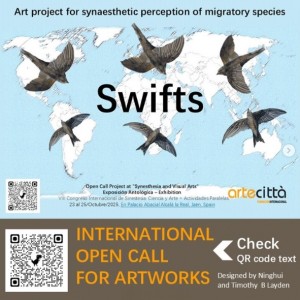
_______________
Hans Viljoen (1989 – ) is an architect-urbanist, writer and researcher with an interest in the heritage and patterns of human inhabitation. His academic and practical experience includes 15 years in architectural schools and practices (in South Africa, Sweden and Vietnam). Hans graduated with a Masters degree in Urbanism at KTH Royal Institute of Technology in Stockholm in 2018, and a Master of Architecture at the University of Pretoria in 2013.
Hans has recently returned from an architectural residency in Vanwyksdorp, Klein Karoo, to lecture a series on ‘building elements’ at the School of Explorative Architecture, Cape Town’s new architecture school. He was also invited by Jeannette Unite to zoom in on a historic aerial shot of Kakamas.
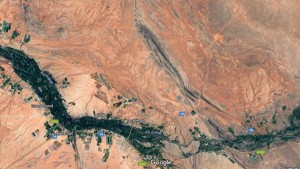
Kakamas along the Orange River, Northern Cape province, South Africa.
The aerial photographic negative, ‘Kakamas 2820 DC 3’ taken in 1977, was chosen from Jeannette Unite’s archive of land photos. Kakamas is a remote mining town in the mineral rich Northern Cape built around irrigation canals on the banks of the Orange River where extensive diamond digging and mining takes place. The various land forms geology captured on this aerial – the river and canals, townscapes, farmlands, and hills – exhibit the different textures, densities and patterns of a landscape that has been stratified into agricultural and real estate portions. The fifteen assemblages reclaim some of the organic shapes embedded in the regimented and owned land. These assemblages form part of Hans’s broader intention to exploration beyond architectural-urban strictures.
_______________
Lonwabo Kilani
Lonwabo’s practice is interdisciplinary. He paints, makes animations, interactive installations and curates. He has completed a BA.MP (Bachelor of Arts in Motion Picture) in Directing animation, Honours in Curatorship and currently studying for my MAFA. A founder of a digital arts residency project ‘Gallery.exe’, co-founder of a collaborative visual arts residency ‘Studio147′ and a member of the artist collective ‘Gugulective’. He serves as a secretary board member of the Greatmore Arts Trust. [Source: https://www.creativeknow.org/fellows-2019/lonwabo-kilani]


